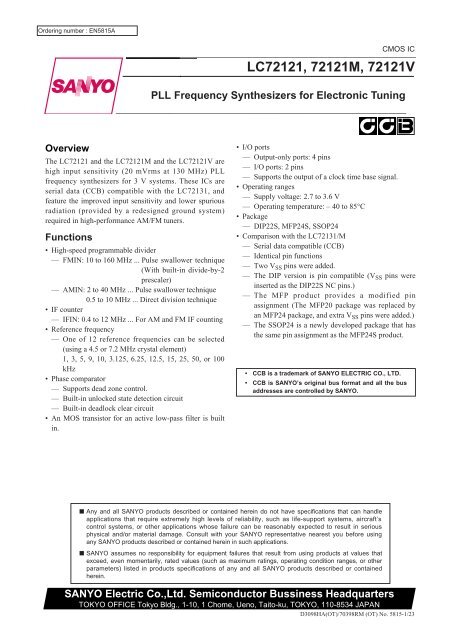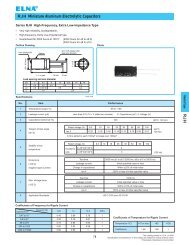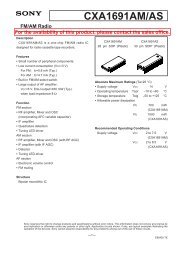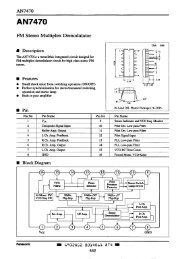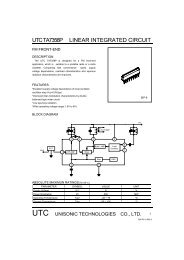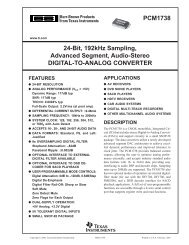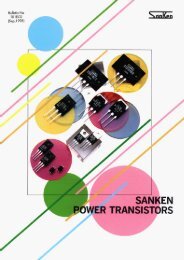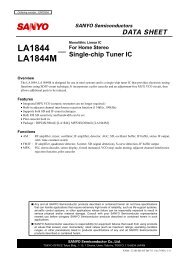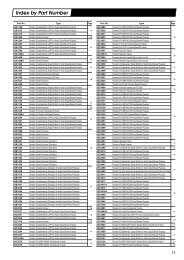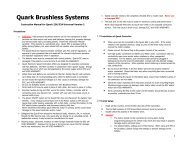LC72121 - PLL Frequency Synthesizers for Electronic ... - MaxDat
LC72121 - PLL Frequency Synthesizers for Electronic ... - MaxDat
LC72121 - PLL Frequency Synthesizers for Electronic ... - MaxDat
Create successful ePaper yourself
Turn your PDF publications into a flip-book with our unique Google optimized e-Paper software.
Ordering number : EN5815A<br />
CMOS IC<br />
<strong>LC72121</strong>, 72121M, 72121V<br />
<strong>PLL</strong> <strong>Frequency</strong> <strong>Synthesizers</strong> <strong>for</strong> <strong>Electronic</strong> Tuning<br />
Overview<br />
The <strong>LC72121</strong> and the <strong>LC72121</strong>M and the <strong>LC72121</strong>V are<br />
high input sensitivity (20 mVrms at 130 MHz) <strong>PLL</strong><br />
frequency synthesizers <strong>for</strong> 3 V systems. These ICs are<br />
serial data (CCB) compatible with the LC72131, and<br />
feature the improved input sensitivity and lower spurious<br />
radiation (provided by a redesigned ground system)<br />
required in high-per<strong>for</strong>mance AM/FM tuners.<br />
Functions<br />
• High-speed programmable divider<br />
— FMIN: 10 to 160 MHz ... Pulse swallower technique<br />
(With built-in divide-by-2<br />
prescaler)<br />
— AMIN: 2 to 40 MHz ... Pulse swallower technique<br />
0.5 to 10 MHz ... Direct division technique<br />
• IF counter<br />
— IFIN: 0.4 to 12 MHz ... For AM and FM IF counting<br />
• Reference frequency<br />
— One of 12 reference frequencies can be selected<br />
(using a 4.5 or 7.2 MHz crystal element)<br />
1, 3, 5, 9, 10, 3.125, 6.25, 12.5, 15, 25, 50, or 100<br />
kHz<br />
• Phase comparator<br />
— Supports dead zone control.<br />
— Built-in unlocked state detection circuit<br />
— Built-in deadlock clear circuit<br />
• An MOS transistor <strong>for</strong> an active low-pass filter is built<br />
in.<br />
• I/O ports<br />
— Output-only ports: 4 pins<br />
— I/O ports: 2 pins<br />
— Supports the output of a clock time base signal.<br />
• Operating ranges<br />
— Supply voltage: 2.7 to 3.6 V<br />
— Operating temperature: – 40 to 85°C<br />
• Package<br />
— DIP22S, MFP24S, SSOP24<br />
• Comparison with the LC72131/M<br />
— Serial data compatible (CCB)<br />
— Identical pin functions<br />
— Two V SS pins were added.<br />
— The DIP version is pin compatible (V SS pins were<br />
inserted as the DIP22S NC pins.)<br />
— The MFP product provides a modified pin<br />
assignment (The MFP20 package was replaced by<br />
an MFP24 package, and extra V SS pins were added.)<br />
— The SSOP24 is a newly developed package that has<br />
the same pin assignment as the MFP24S product.<br />
• CCB is a trademark of SANYO ELECTRIC CO., LTD.<br />
• CCB is SANYO’s original bus <strong>for</strong>mat and all the bus<br />
addresses are controlled by SANYO.<br />
Any and all SANYO products described or contained herein do not have specifications that can handle<br />
applications that require extremely high levels of reliability, such as life-support systems, aircraft’s<br />
control systems, or other applications whose failure can be reasonably expected to result in serious<br />
physical and/or material damage. Consult with your SANYO representative nearest you be<strong>for</strong>e using<br />
any SANYO products described or contained herein in such applications.<br />
SANYO assumes no responsibility <strong>for</strong> equipment failures that result from using products at values that<br />
exceed, even momentarily, rated values (such as maximum ratings, operating condition ranges, or other<br />
parameters) listed in products specifications of any and all SANYO products described or contained<br />
herein.<br />
SANYO Electric Co.,Ltd. Semiconductor Bussiness Headquarters<br />
TOKYO OFFICE Tokyo Bldg., 1-10, 1 Chome, Ueno, Taito-ku, TOKYO, 110-8534 JAPAN<br />
D3098HA(OT)/70398RM (OT) No. 5815-1/23
<strong>LC72121</strong>, 72121M, 72121V<br />
Specifications<br />
Absolute Maximum Ratings at Ta = 25°C, V SSd = V SSa = V SSX = 0 V<br />
Parameter Symbol Conditions Ratings Unit<br />
Maximum supply voltage V DD max V DD –0.3 to +7.0 V<br />
V IN 1 max CE, DI, CL, AIN –0.3 to +7.0 V<br />
Maximum input voltage V IN 2 max XIN, FMIN, AMIN, IFIN –0.3 to V DD +0.3 V<br />
V IN 3 max IO1, IO2 –0.3 to +15 V<br />
V O 1 max DO –0.3 to +7.0 V<br />
Maximum output voltage V O 2 max XOUT, PD –0.3 to V DD +0.3 V<br />
V O 3 max BO1 to BO4, IO1, IO2, AOUT –0.3 to +15 V<br />
Maximum output current<br />
I O 1 max DO, AOUT 0 to +6.0 mA<br />
I O 2 max BO1 to BO4, IO1, IO2 0 to +10.0 mA<br />
DIP22S: 350 mW<br />
Allowable power dissipation Pd max (Ta ≤ 85°C) MFP24S: 200 mW<br />
SSOP24: 150 mW<br />
Operating temperature Topr –40 to +85 °C<br />
Storage temperature Tstg –55 to +125 °C<br />
Allowable Operating Ranges at Ta = – 40 to +85°C, V SSd = V SSa = V SSX = 0 V<br />
Parameter Symbol Conditions<br />
min<br />
Ratings<br />
typ max<br />
Unit<br />
Supply voltage V DD V DD 2.7 3.6 V<br />
Input high-level voltage<br />
V IH 1 CE, DI, CL 0.7 V DD 6.5 V<br />
V IH 2 IO1, IO2 0.7 V DD 13 V<br />
Input low-level voltage V IL CE, DI, CL, IO1, IO2 0 0.3 V DD V<br />
Output voltage<br />
V O 1 DO 0 6.5 V<br />
V O 2 BO1 to BO4, IO1, IO2, AOUT 0 13 V<br />
f IN 1 XIN: V IN 1 1 8 MHz<br />
f IN 2 FMIN: V IN 2 10 160 MHz<br />
Input frequency f IN 3 AMIN (SNS = 1): V IN 3 2 40 MHz<br />
f IN 4 AMIN (SNS = 0): V IN 4 0.5 10 MHz<br />
f IN 5 IFIN: V IN 5 0.4 12 MHz<br />
V IN 1 XIN: f IN 1 200 800 mVrms<br />
V IN 2-1 FMIN: f = 10 to 130 MHz 20 800 mVrms<br />
V IN 2-2 FMIN: f = 130 to 160 MHz 40 800 mVrms<br />
Input amplitude V IN 3 AMIN (SNS = 1): f IN 3 40 800 mVrms<br />
V IN 4 AMIN (SNS = 0): f IN 4 40 800 mVrms<br />
V IN 5-1 IFIN: f IN 5, IFS = 1 40 800 mVrms<br />
V IN 5-2 IFIN: f IN 5, IFS = 0 70 800 mVrms<br />
Guaranteed crystal oscillator frequency Xtal XIN, XOUT: * 4 8 MHz<br />
Note:<br />
Recommended value <strong>for</strong> CI <strong>for</strong> the crystal oscillator element: CI ≤ 120Ω (4.5MHz), CI ≤ 70Ω (7.2MHz)<br />
Electrical Characteristics in the Allowable Operating Ranges<br />
Parameter Symbol Conditions<br />
min<br />
Ratings<br />
typ max<br />
Unit<br />
Rf1 XIN 1 MΩ<br />
Internal feedback resistance<br />
Rf2 FMIN 500 kΩ<br />
Rf3 AMIN 500 kΩ<br />
Rf4 IFIN 250 kΩ<br />
Internal pull-down resistance<br />
Rpd1 FMIN 100 200 400 kΩ<br />
Rpd2 AMIN 100 200 400 kΩ<br />
Hysteresis V HIS CE, DI, CL 0.1 V DD V<br />
Output high-level voltage V OH 1 PD: I O = –1 mA V DD – 1.0 V<br />
Continued on next page.<br />
No. 5815-4/23
Procedures <strong>for</strong> Input and Output of Serial Data<br />
<strong>LC72121</strong>, 72121M, 72121V<br />
This product uses the CCB (Computer Control Bus), which is Sanyo’s audio product serial bus <strong>for</strong>mat, <strong>for</strong> data input and<br />
output. This product adopts an 8-bit address CCB <strong>for</strong>mat.<br />
Address<br />
I/O mode<br />
B0 B1 B2 B3 A0 A1 A2 A3<br />
1 IN1 (82) 0 0 0 1 0 1 0 0<br />
2 IN2 (92) 1 0 0 1 0 1 0 0<br />
3 OUT (A2) 0 1 0 1 0 1 0 0<br />
Function<br />
• Control data input (serial data input) mode<br />
• 24 bits of data are input.<br />
• See the “DI Control Data (serial data input)” section <strong>for</strong> details on the<br />
content of the input data.<br />
• Control data input (serial data input) mode<br />
• 24 bits of data are input.<br />
• See the “DI Control Data (serial data input)” section <strong>for</strong> details on the<br />
content of the input data.<br />
• Data output (serial data output) mode<br />
• The number of bits output is equal to the number of clock cycles.<br />
• See the “DO output Data (serial data output)” section <strong>for</strong> details on the<br />
content of the output data.<br />
I/O mode determined<br />
Normally high<br />
Normally low<br />
No. 5815-7/23
Structure of the DI Control Data (serial data input)<br />
• IN1 mode<br />
<strong>LC72121</strong>, 72121M, 72121V<br />
• IN2 mode<br />
No. 5815-8/23
<strong>LC72121</strong>, 72121M, 72121V<br />
DI Control Data<br />
No. Control block/data Function Related data<br />
• Specifies the divisor <strong>for</strong> the programmable divider.<br />
This is a binary value in which P15 is the MSB. The LSB changes depending on DVS and SNS.<br />
(* : don’t care)<br />
DVS SNS LSB Set divisor (N) Actual divisor<br />
1 * P0 272 to 65535 Twice the set value<br />
0 1 P0 272 to 65535 The set value<br />
1<br />
Programmable<br />
divider data<br />
P0 to P15<br />
DVS, SNS<br />
0 0 P4 4 to 4095 The set value<br />
* LSB: When P4 is the LSB, P0 to P3 are ignored.<br />
• These pins select the signal input to the programmable divider (FMIN or AMIN) and switch the input<br />
frequency range.<br />
(* : don’t care)<br />
DVS SNS Input pin <strong>Frequency</strong> range accepted by the input pin<br />
1 * FMIN 10 to 160 MHz<br />
0 1 AMIN 2 to 40 MHz<br />
0 0 AMIN 0.5 to 10 MHz<br />
* See the “Structure of the Programmable Divider” section <strong>for</strong> details.<br />
• Reference frequency selection<br />
R3 R2 R1 R0 Reference frequency<br />
0 0 0 0 100 kHz<br />
0 0 0 1 50<br />
0 0 1 0 25<br />
0 0 1 1 25<br />
0 1 0 0 12.5<br />
0 1 0 1 6.25<br />
0 1 1 0 3.125<br />
0 1 1 1 3.125<br />
2<br />
Reference divider<br />
data<br />
R0 to R3<br />
XS<br />
1 0 0 0 10<br />
1 0 0 1 9<br />
1 0 1 0 5<br />
1 0 1 1 1<br />
1 1 0 0 3<br />
1 1 0 1 15<br />
1 1 1 0 <strong>PLL</strong> INHIBIT + Xtal OSC STOP<br />
1 1 1 1 <strong>PLL</strong> INHIBIT<br />
* <strong>PLL</strong> INHIBIT mode<br />
In this mode, the programmable divider and the IF counter block are stopped, the FMIN, AMIN, and IFIN<br />
pins are pulled down to ground, and the charge pump output goes to the high-impedance state.<br />
• Crystal oscillator element selection data<br />
XS = 0: 4.5 MHz<br />
XS = 1: 7.2 MHz<br />
Note that 7.2 MHz is selected after a power on reset.<br />
• IF counter measurement start command data<br />
CTE = 1: Starts the counter<br />
CTE = 0: Resets the counter<br />
3<br />
IF counter control<br />
data<br />
CTE<br />
GT0, GT1<br />
• Determines the IF counter measurement time.<br />
GT1 GT0 Measurement time Wait time<br />
0 0 4 ms 3 to 4 ms<br />
0 1 8 3 to 4<br />
IFS<br />
1 0 32 7 to 8<br />
1 1 64 7 to 8<br />
* See the “Structure of the IF Counter” section <strong>for</strong> details.<br />
Continued on next page.<br />
No. 5815-9/23
<strong>LC72121</strong>, 72121M, 72121V<br />
Continued from preceding page.<br />
No. Control block/data Function Related data<br />
4<br />
I/O port setup data<br />
IOC1,IOC2<br />
• Specifies input or output <strong>for</strong> the shared function I/O pins (IO1 and IO2).<br />
Data = 0: Input port<br />
Data = 1: Output port<br />
5<br />
Output port data<br />
BO1 to BO4<br />
IO1,IO2<br />
• Determines the output state of the BO1 through BO4, IO1, and IO2 output ports.<br />
Data = 0: Open<br />
Data = 1: Low level<br />
• The data is reset to 0, setting the pins to the open state, after a power on reset.<br />
IOC1<br />
IOC2<br />
• Determines the DO pin output.<br />
DOC2 DOC1 DOC0 DO pin state<br />
0 0 0 Open<br />
0 0 1 Low when the <strong>PLL</strong> is unlocked<br />
0 1 0 end-UC *1<br />
0 1 1 Open<br />
1 0 0 Open<br />
1 0 1 The IO1 pin state *2<br />
1 1 0 The IO2 pin state *2<br />
1 1 1 Open<br />
6<br />
DO pin control data<br />
DOC0<br />
DOC1<br />
DOC2<br />
The open state is selected after a power on reset.<br />
*1. end-UC: IF counter measurement end check<br />
UL0, UL1<br />
CTE<br />
IOC1<br />
IOC2<br />
(1)When end-UC is selected and an IF count is started (by switching CTE from 0 to 1), the DO pin<br />
automatically goes to the open state.<br />
(2)When the IF counter measurement period completes, the DO pin goes to the low level, allowing<br />
applications to test <strong>for</strong> the completion of the count period.<br />
(3)The DO pin is set to the open state by per<strong>for</strong>ming a serial data input or output operation (when the CE<br />
pin is set high).<br />
*2. The DO pin will go to the open state if the corresponding IO pin is set up to be an output port.<br />
Note: During the data input period (the period that CE is high in IN1 or IN2 mode), the DO pin goes to the<br />
open state regardless of the DO pin control data (DOC0 to DOC2). During the data output period (the<br />
period that CE is high in OUT mode) the DO pin state reflects the internal DO serial data in<br />
synchronization with the CL clock, regardless of the DO pin control data (DOC0 to DOC2).<br />
• Selects the width of the phase error (øE) detected <strong>for</strong> <strong>PLL</strong> lock state discrimination. The state is taken to<br />
be unlocked if a phase error in excess of the detection width occurs.<br />
7<br />
Unlocked state<br />
detection data<br />
UL0, UL1<br />
UL1 UL0 øE detection width Detection output<br />
0 0 Stopped Open<br />
0 1 0 øE is output directly<br />
1 0 ±0.55 µs øE is extended by 1 to 2 ms<br />
DOC0<br />
DOC1<br />
DOC2<br />
1 1 ±1.11 µs øE is extended by 1 to 2 ms<br />
* When the <strong>PLL</strong> is unlocked, the DO pin goes low and UL in the serial data output is set to 0.<br />
• Controls the phase comparator dead zone<br />
DZ1 DZ Dead zone mode<br />
8<br />
Phase comparator<br />
control data<br />
DZ0, DZ1<br />
0 0 DZA<br />
0 1 DZB<br />
1 0 DZC<br />
1 1 DZD<br />
Dead zone width: DZA < DZB < DZC < DZD<br />
Continued on next page.<br />
No. 5815-10/23
<strong>LC72121</strong>, 72121M, 72121V<br />
Continued from preceding page.<br />
No. Control block/data Function Related data<br />
9<br />
Clock time base<br />
TBC<br />
• Setting the TBC bit to 1 causes an 8-Hz clock time base signal with a 40% duty to be output from the<br />
BO1 pin. (The BO1 data will be ignored.)<br />
BO1<br />
• Forcibly controls the charge pump output.<br />
DLC<br />
Charge pump output<br />
10<br />
Charge pump<br />
control data<br />
DLC<br />
0 Normal operation<br />
1 Forced to low<br />
* If the circuit deadlocks due to the VCO control voltage (Vtune) being 0 and the VCO being stopped,<br />
applications can get out of the deadlocked state by setting the charge pump output to low and setting<br />
Vtune to V CC . (Deadlock clear circuit)<br />
11<br />
IF counter control<br />
data<br />
IFS<br />
• This data is normally set to 1. Setting this data to 0 sets the circuit to reduced input sensitivity mode, in<br />
which the sensitivity is reduced by about 10 to 30 mV rms.<br />
* See the “IF Counter Operation” section <strong>for</strong> details.<br />
12<br />
Test data<br />
TEST0 to 2<br />
• Test data<br />
TEST0<br />
TEST1 All these bits must be set to 0.<br />
TEST2<br />
All these bits are set to 0 after a power on reset.<br />
13 DNC • This bit must be set to 0.<br />
Structure of the DO Output Data (serial data output)<br />
• OUT mode<br />
DO Output Data<br />
No. Control block/data Function Related data<br />
1<br />
2<br />
3<br />
I/O port data<br />
12, I1<br />
<strong>PLL</strong> unlocked state<br />
data<br />
UL<br />
IF counter binary<br />
data<br />
C19 to C0<br />
• Data latched from the I/O port IO1 or IO2 pin states.<br />
• These bits reflect the pin states regardless of the I/O port mode (input or output).<br />
The data is latched at the point the circuit enters data output mode (OUT mode).<br />
I1 ← The IO1 pin state H : 1<br />
I2 ← The IO2 pin state L : 0<br />
• Indicates the state of the unlocked state detection circuit.<br />
UL ← 0: When the <strong>PLL</strong> is unlocked.<br />
UL ← 1: When the <strong>PLL</strong> is locked or in the detection disabled mode.<br />
• Indicates the value of the IF counter (20-bit binary counter).<br />
C19 ← MSB of the binary counter<br />
C0 ← LSB of the binary counter<br />
IOC1<br />
IOC2<br />
UL0<br />
UL1<br />
CTE<br />
GT0<br />
GT1<br />
No. 5815-11/23
<strong>LC72121</strong>, 72121M, 72121V<br />
Serial Data Input (IN1/IN2) t SU , t HD , t EL , t ES , t EH ≥ 0.75 µs t LC < 0.75 µs<br />
• CL: Normally high<br />
• CL: Normally low<br />
Serial Data Output (Out) t SU , t HD , t EL , t ES , t EH ≥ 0.75 µs t DC , t DH < 0.35 µs<br />
• CL: Normally high<br />
• CL: Normally low<br />
Note:<br />
The data conversion times (t DC and t DH ) depend on the value of the pull-up resistor and the printed circuit board capacitance since the DO pin is an<br />
n-channel open-drain circuit.<br />
No. 5815-12/23
<strong>LC72121</strong>, 72121M, 72121V<br />
Serial Data Timing<br />
When CL is Stopped at the Low Level<br />
When CL is Stopped at the High Level<br />
Parameter Symbol Conditions<br />
min<br />
Ratings<br />
typ max<br />
Unit<br />
Data setup time t SU DI, CL 0.75 µs<br />
Data hold time t HD DI, CL 0.75 µs<br />
Clock low level time t CL CL 0.75 µs<br />
Clock high level time t CH CL 0.75 µs<br />
CE wait time t EL CE, CL 0.75 µs<br />
CE setup time t ES CE, CL 0.75 µs<br />
CE hold time t EH CE, CL 0.75 µs<br />
Data latch change time t LC 0.75 µs<br />
Data output time<br />
t DC DO, CL These values differ depending on the value of the pull-up 0.35 µs<br />
t DH DO, CE resistor used and the printed circuit board capacitance. 0.35 µs<br />
No. 5815-13/23
Structure of the Programmable Divider<br />
<strong>LC72121</strong>, 72121M, 72121V<br />
DVS SNS Input pin Set divisor Actual divisor Input frequency range<br />
A 1 * FMIN 272 to 65535 Twice the set value 10 to 160 MHz<br />
B 0 1 AMIN 272 to 65535 The set value 2 to 40 MHz<br />
C 0 0 AMIN 4 to 4095 The set value 0.5 to 10 MHz<br />
*: Don’t care<br />
Sample Programmable Divider Divisor Calculations<br />
• For FM with a step size of 50 kHz (DVS = 1, SNS = *: FMIN selected)<br />
FM RF = 90.0 MHz (IF +10.7 MHz)<br />
FM VCO = 100.7 MHz<br />
<strong>PLL</strong> fref = 25 kHz (R0 = 0, R1 = 1, R2 = 0, R3 = 0)<br />
100.7 MHz (FM VCO) ÷ 25 kHz (fref) ÷ 2 (<strong>for</strong> the FMIN 1/2 prescaler) 2014 → 07DE (hexadecimal)<br />
• For SW with a step size of 5 kHz (DVS = 0, SNS = 1: AMIN high-speed operation selected)<br />
SW RF = 21.75 MHz (IF +450 kHz)<br />
SW VCO = 22.20 MHz<br />
<strong>PLL</strong> fref = 5 kHz (R0 = 0, R1 = 1, R2 = 0, R3 = 1)<br />
22.2 MHz (SW VCO) ÷ 5 kHz (fref) = 4440 → 1158 (hexadecimal)<br />
• For MW with a step size of 9 kHz (DVS = 0, SNS = 0: AMIN low-speed operation selected)<br />
MW RF = 1008 kHz (IF +450 kHz)<br />
WM VCO = 1458 kHz<br />
<strong>PLL</strong> fref =9 kHz (R0 = 1, R1 = 0, R2 = 0, R3 = 1)<br />
1458 (MW VCO) ÷ 9 kHz (fref) = 162 → 0A2 (hexadecimal)<br />
No. 5815-14/23
<strong>LC72121</strong>, 72121M, 72121V<br />
Structure of the IF Counter<br />
The <strong>LC72121</strong> IF counter is a 20-bit binary counter, and takes the IF signal from the IFIN pin as its input. The result of<br />
the count can be read out serially, MSB first, from the DO pin.<br />
Measurement time<br />
GT1 GT0<br />
Measurement time (GT) Wait time (t WU )<br />
0 0 4 ms 3 to 4 ms<br />
0 1 8 3 to 4 ms<br />
1 0 32 7 to 8 ms<br />
1 1 64 7 to 8 ms<br />
The IF frequency (Fc) is measured by determining how many pulses were input to the IF counter in the stipulated<br />
measurement time, GT.<br />
Fc =——<br />
C<br />
(C = Fc x GT) C: Counted value (the number of pulses)<br />
GT<br />
IF Counter <strong>Frequency</strong> Measurement Examples<br />
• When the measurement time (GT) is 32 ms and the counted value (C) is 53980 (hexadecimal) or 342,400 (decimal).<br />
IF frequency (F C ) = 342400 ÷ 32 ms = 10.7 MHz<br />
• When the measurement time (GT) is 8 ms and the counted value (C) is E10 (hexadecimal) or 3600 (decimal).<br />
IF frequency (F C ) = 3600 ÷ 8 ms = 450 kHz<br />
No. 5815-15/23
<strong>LC72121</strong>, 72121M, 72121V<br />
IF Counter Operation<br />
Applications must first, be<strong>for</strong>e starting an IF count operation reset the IF counter by setting CTE in the serial data to 0.<br />
The IF counter operation is started setting CTE in the serial data from 0 to 1. Although the serial data is latched by<br />
dropping the CE pin from high to low, the IF signal input to the IFIN pin must be provided within the wait time from the<br />
point CE goes low. Next, the readout of the IF counter after measurement is complete must be per<strong>for</strong>med while CTE is<br />
still 1, since the counter will be reset if CTE is set to 0.<br />
Note: If IF counting is used, applications must determine whether or not the IF IC SD (station detect) signal is present in<br />
the microcontroller software, and per<strong>for</strong>m the IF count only if that signal is asserted. This is because auto-search<br />
techniques that use IF counting only are subject to incorrect stopping at points where there is no station due to IF<br />
buffer leakage.<br />
Note that the <strong>LC72121</strong> input sensitivity can be controlled with the IFS bit in the serial data.<br />
Reduced sensitivity mode (IFS = 0) must be selected when this IC is used in conjunction with an IF IC that does<br />
not provide an SD output and auto-search is implemented using only IF counting.<br />
IFIN Minimum Sensitivity Standard<br />
Input frequency : f [MHz]<br />
IFS data 0.4 ≤ f < 0.5 0.5 ≤ f < 8 8 ≤ f ≤ 12<br />
1(Normal mode) 40 mVrms (0.1 to 3 mVrms) 40 mVrms 40 mVrms (1 to 15 mVrms)<br />
0 (Degraded sensitivity mode) 70 mVrms (5 to 10 mVrms) 70 mVrms 70 Vrms (30 to 40 mVrms)<br />
Note: Values in parentheses are actual per<strong>for</strong>mance values that are provided <strong>for</strong> reference purposes.<br />
No. 5815-16/23
<strong>LC72121</strong>, 72121M, 72121V<br />
Unlocked State Detection Timing<br />
• Unlocked state detection timing<br />
Unlocked state detection is per<strong>for</strong>med during the reference frequency (fref) period (interval). This means that a period<br />
at least as long as the period of the reference frequency is required to recognize the locked/unlocked state. However,<br />
applications must wait at least twice the period of the reference frequency immediately after changing the divisor (N)<br />
be<strong>for</strong>e checking the locked/unlocked state.<br />
Figure 1 Unlocked State Detection Timing<br />
For example, if fref is 1 kHz (a period of 1 ms) applications must wait at least 2 ms after the divisor N is changed<br />
be<strong>for</strong>e per<strong>for</strong>ming a locked/unlocked check.<br />
Figure 2 Circuit Structure<br />
No. 5815-17/23
<strong>LC72121</strong>, 72121M, 72121V<br />
Figure 3 Combining with Software<br />
• Outputting the unlocked state data in the serial data<br />
At the point of data output 1 in figure 3, the unlocked state data will indicate the unlocked state, since the VCO<br />
frequency is not stable (locked) yet. In cases such as this, the application should wait at least one whole period and then<br />
check again whether or not the frequency has stabilized with the data output 2 operation in the figure. Applications can<br />
implement even more reliable recognition of the locked state by per<strong>for</strong>ming several more checks of the state and<br />
requiring that the locked state be detected sequentially.<br />
<br />
Divisor N changed (data input)<br />
Wait at least 2 reference frequency periods.<br />
Data output (1)<br />
Data output (2)<br />
Valid output data is acquired by using an interval of at<br />
least one reference frequency period.<br />
Locked state check<br />
*<br />
YES<br />
NO<br />
*: Even more reliable recognition of the locked state<br />
can be achieved by per<strong>for</strong>ming several checks of the<br />
state and requiring that the locked state be detected<br />
sequentially.<br />
A10180<br />
• Directly outputting the unlocked state to the DO pin<br />
Since the unlocked state (high level when locked, low when unlocked) is output from the DO pin, applications can<br />
check <strong>for</strong> the locked state by waiting at least two reference frequency periods after changing the divisor N. However, in<br />
this case also, even more reliable recognition of the locked state can be achieved by per<strong>for</strong>ming several checks of the<br />
state and requiring that the locked state be detected sequentially.<br />
No. 5815-18/23
<strong>LC72121</strong>, 72121M, 72121V<br />
Clock Time Base Usage Notes<br />
When using the clock time base output function, the output pin (BO1) pull-up resistor must have a value of over 100 kΩ.<br />
The use of a Schmitt input in the microcontroller that accepts this signal is recommended to reduce chattering. This is to<br />
prevent degradation of the VCO C/N characteristics when combining with a loop filter that uses the internal transistor<br />
provided to <strong>for</strong>m a low-pass filter. Although the ground <strong>for</strong> the clock time base output pin (V SSd ) and the ground <strong>for</strong> the<br />
transistor (V SSa ) are isolated internally on the chip, applications must take care to avoid ground loops and minimize<br />
current fluctuations in the time base pin to prevent degradation of the low-pass filter characteristics.<br />
Pin States after a Power on Reset<br />
No. 5815-19/23
<strong>LC72121</strong>, 72121M, 72121V<br />
Sample Application Circuit<br />
(Using the DIP22S package)<br />
Since this is a high-impedance circuit,<br />
it is susceptible to noise. There<strong>for</strong>e,<br />
lines in the printed circuit board<br />
pattern should be made as short as<br />
possible and it should be surrounded<br />
by the ground pattern.<br />
No. 5815-20/23
<strong>LC72121</strong>, 72121M, 72121V<br />
Other Items<br />
• Notes on the phase comparator dead zone<br />
DZ1 DZ0 Dead zone mode Charge pump Dead zone<br />
0 0 DZA ON/ON – –0s<br />
0 1 DZB ON/ON –0s<br />
1 0 DZC OFF/OFF +0s<br />
1 1 DZD OFF/OFF + +0s<br />
When the charge pump is used with one of the ON/ON modes, correction pulses are generated from the charge pump<br />
even if the <strong>PLL</strong> is locked. As a result, it is easy <strong>for</strong> the loop to become unstable, and special care is required in<br />
application design. The following problems can occur if an ON/ON mode is used.<br />
— Sidebands may be created by reference frequency leakage.<br />
— Sidebands may be created by low-frequency leakage due to the correction pulse envelope.<br />
Although the loop is more stable when a dead zone is present (i.e. when an OFF/OFF mode is used), a dead zone<br />
makes it more difficult to achieve excellent C/N characteristics. On the other hand, while it is easy to achieve good C/N<br />
characteristics when there is no dead zone, achieving good loop stability is difficult. Accordingly, the DZA and DZB<br />
settings, in which there is no dead zone, can be effective in situations where a signal-to-noise ratio of 90 to 100 dB or<br />
higher is required in FM reception, or where it is desirable to increase the pilot margin in AM stereo reception.<br />
However, if such a high signal-to-noise ratio is not required <strong>for</strong> FM reception, if an adequate pilot margin can be<br />
acquired in AM stereo reception, or if AM stereo is not required, then either DZC or DZD, in which there is a dead<br />
zone, should be chosen.<br />
Dead Zone<br />
As shown in figure 1, the phase comparator compares a reference frequency (fr) with fp. As shown in figure 2, the phase<br />
comparator's characteristics consist of an output voltage (V) that is proportional to the phase difference ø. However, due<br />
to internal circuit delay and other factors, an actual circuit has a region (the dead zone, B) where the circuit cannot<br />
actually compare the phases. To implement a receiver with a high S/N ratio, it is desirable that this region be as small as<br />
possible. However, it is often desirable to have the dead zone be slightly wider in popularly-priced models. This is<br />
because in certain cases, such as when there is a strong RF input, popularly-priced models can suffer from mixer to VCO<br />
RF leakage that modulates the VCO. When the dead zone is small, the circuit outputs signals to correct this modulation<br />
and this output further modulates the VCO. This further modulation may then generate beats and the RF signal.<br />
Figure 1 Figure 2<br />
• Notes on the FMIN, AMIN, and IFIN pins<br />
Coupling capacitors should be placed as close to their pin as possible. A capacitance of about 100 pF is desirable <strong>for</strong><br />
these capacitors. In particular, if the IFIN pin coupling capacitor is not held under 1000 pF, the time to reach the bias<br />
level may become excessive and incorrect counts may result due to the relationship with the wait time.<br />
• Notes on IF counting → Use the SD signal in conjunction with IF counting<br />
When counting the IF frequency, the microcontroller must determine the presence or absence of the IF IC SD (station<br />
detect) signal and turn on the IF counter buffer output and execute the IF count only if there is an SD signal. Autosearch<br />
techniques that only use the IF counter are subject to incorrect stopping at points where there is no station due to<br />
IF buffer leakage.<br />
No. 5815-21/23
<strong>LC72121</strong>, 72121M, 72121V<br />
• DO pin usage<br />
The DO pin can be used <strong>for</strong> IF counter count completion checking and as an unlock detection output in addition to its<br />
use in data output mode. It is also possible to have the DO pin reflect the state of an input pin to input that state to the<br />
microcontroller.<br />
• Power supply pins<br />
Capacitors must be inserted between the power supply V DD and V SS pins <strong>for</strong> noise exclusion. These capacitors must be<br />
placed as close as possible to the V DD and V SS pins.<br />
• VCO setup<br />
Applications must be designed so that the VCO (local oscillator) does not stop, even if the control voltage (Vtune) goes<br />
to 0 V. If it is possible <strong>for</strong> the oscillator to stop, the application must use the control data (DLC) to temporarily <strong>for</strong>ce<br />
Vtune to V CC to prevent deadlock from occurring. (Deadlock clear circuit)<br />
• Front end connection example<br />
Since this product (and the LC72131 as well) is designed with the relatively high resistance of 200 kΩ <strong>for</strong> the pulldown<br />
(on) resistors built in to the FMIN and AMIN pins, a common AM/FM local oscillator buffer can be used as<br />
shown in the following circuit.<br />
• PD pin<br />
Note that the charge pump output voltage is reduced when this IC, which is a 3-V system, is used to replace the<br />
LC72131, which is a 5-V system. This means that since the loop gain is reduced, the loop filter constants, the lock time<br />
(SD wait time), and other related parameters must be reevaluated in the end product design.<br />
No. 5815-22/23
<strong>LC72121</strong>, 72121M, 72121V<br />
Specifications of any and all SANYO products described or contained herein stipulate the per<strong>for</strong>mance,<br />
characteristics, and functions of the described products in the independent state, and are not guarantees<br />
of the per<strong>for</strong>mance, characteristics, and functions of the described products as mounted in the customer’s<br />
products or equipment. To verify symptoms and states that cannot be evaluated in an independent device,<br />
the customer should always evaluate and test devices mounted in the customer’s products or equipment.<br />
SANYO Electric Co., Ltd. strives to supply high-quality high-reliability products. However, any and all<br />
semiconductor products fail with some probability. It is possible that these probabilistic failures could<br />
give rise to accidents or events that could endanger human lives, that could give rise to smoke or fire,<br />
or that could cause damage to other property. When designing equipment, adopt safety measures so<br />
that these kinds of accidents or events cannot occur. Such measures include but are not limited to protective<br />
circuits and error prevention circuits <strong>for</strong> safe design, redundant design, and structural design.<br />
In the event that any or all SANYO products (including technical data, services) described or contained<br />
herein are controlled under any of applicable local export control laws and regulations, such products must<br />
not be exported without obtaining the export license from the authorities concerned in accordance with the<br />
above law.<br />
No part of this publication may be reproduced or transmitted in any <strong>for</strong>m or by any means, electronic or<br />
mechanical, including photocopying and recording, or any in<strong>for</strong>mation storage or retrieval system,<br />
or otherwise, without the prior written permission of SANYO Electric Co., Ltd.<br />
Any and all in<strong>for</strong>mation described or contained herein are subject to change without notice due to<br />
product/technology improvement, etc. When designing equipment, refer to the “Delivery Specification”<br />
<strong>for</strong> the SANYO product that you intend to use.<br />
In<strong>for</strong>mation (including circuit diagrams and circuit parameters) herein is <strong>for</strong> example only; it is not<br />
guaranteed <strong>for</strong> volume production. SANYO believes in<strong>for</strong>mation herein is accurate and reliable, but<br />
no guarantees are made or implied regarding its use or any infringements of intellectual property rights<br />
or other rights of third parties.<br />
This catalog provides in<strong>for</strong>mation as of December, 1998. Specifications and in<strong>for</strong>mation herein are<br />
subject to change without notice.<br />
PS No. 5815-23/23
This datasheet has been download from:<br />
www.datasheetcatalog.com<br />
Datasheets <strong>for</strong> electronics components.


